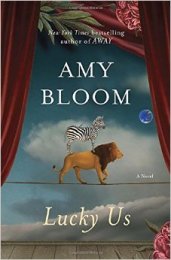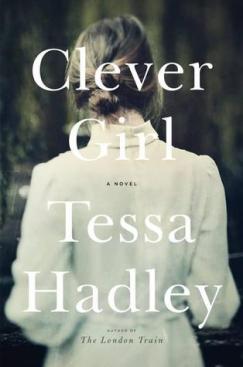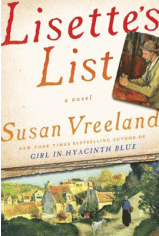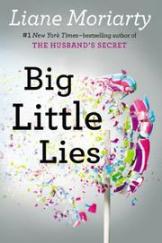As a working writer, I read not only for the passport and pleasure books bring — I read to become a better writer. As I go along, I think about what makes me love a book or put it aside without finishing. This is where I get to write about books, and about reading as a writer.
Review: Lucky Us by Amy Bloom; Random House, 2014
 You don’t really know much about a writer after reading just one book. A single book can be a one-time inspiration, a learning experience the writer will soon top, a good idea that didn’t pan out as the writer hoped, or a so-so idea that struck the right nerve at the right moment to become a good read. Anything can happen.
You don’t really know much about a writer after reading just one book. A single book can be a one-time inspiration, a learning experience the writer will soon top, a good idea that didn’t pan out as the writer hoped, or a so-so idea that struck the right nerve at the right moment to become a good read. Anything can happen.
I’ve now read two Amy Bloom books and am getting to know her better. The first, Away, traces the journey of a young woman’s search for her daughter, the only possible survivor, besides the narrator herself, of a violent pogrom back in their native Russia. Like Away, Bloom’s new book, Lucky Us, is packed with characters and storyline shifts. Asked to assign it to a genre, I’d describe it as serious picaresque. Both books are messy and unpredictable. In Bloom’s hands, both of these are good things.
Neither book is particularly long – Away is a shade under 250 pages, Lucky Us just 234 – but Bloom can move a story like a locomotive, and this alone makes reading her a worthwhile lesson for writers like me whose natural inclination is to give the back story, in all its permutations, back to Adam and Eve before advancing the plot.
The most impressive thing about Bloom’s writing, however, is her ability to create memorable characters in a few deft brushstrokes. This isn’t easy. I have read reams of critically acclaimed novels whose characters I can’t remember at all. This seems to be a particular problem in contemporary fiction. Who, after all, forgets Emma Bovary or Hester Prynne? Heathcliff or Captain Ahab? But ask me about any character worth remembering in Joyce Carol Oates or Nadine Gordimer and you’ll hear crickets chirping. It sometimes seems a perverse point of pride among the literati to thin characters to the point of erasure.
Tolstoy was a master of creating characters in tight spaces, sometimes creating them in a few lines, then dismissing them forever. Bloom works in the same vein, transforming her slim book into a lush, fully-populated sphere. Minor characters, in their brief moments on stage, live as vividly as major ones; major characters are built up brush stroke by brush stroke, so our view of them is constantly amplified. It is much the same with Bloom’s settings, especially the fleeting ones, and beyond the main locales, Bloom gives us sharply carved tableaux of Hollywood in the 1930s and the life of a deportee in Hitler’s Germany.
As I read Lucky Us, I tried to imagine synopsizing the plot as a proposal for a yet-to-be-written book and trying to get an editor to bid it based on plot alone. Yeah, so? the editor would say. Yeah, so, in this case it’s the getting there that matters, and the characters you meet along the way.
Jury of One: Would I read this book again? Yes, and am reserving the ones I haven’t read yet.
Review: Big Little Lies by Liane Moriarty; Einhorn/Putnam, 2014
I think we’re far enough away from 1951’s Levittown to assume that most American readers – and most American writers – grew up in some form of suburb. I mean, the idea was so appealing to young, housing-starved, post-war families that by 1960, a mere 9 years later, half the country was living in bedroom communities.
I was one of them. Our modest, brand spanking new ranch rambler with garbage disposal, picture window and aqua kitchen preceded the roads in our development. Tumbleweeds blew across the yet-to-be-sodded lawn and the nearest grocery store was a suburb away. It was a lot like Little House on the Prairie with wall-to-wall carpeting. Bit by bit, the place filled up. They paved the roads, other families moved in, bridge clubs formed and the book mobile was replaced by a branch library. Osseo District #279 built one, and sometimes two, new schools a year to make room for all of us.
Looking back, I see that watching a suburb grow into its first set of trees was a unique experience, as distinct as Conrad Richter’s The Awakening Land trilogy. I loved Richter’s books, as I loved all pioneer historicals at that time in my life. Yet I never loved my own experience. Never wanted to write about it, never regarded it with that piercing throb I felt reading Winesburg, Ohio or Raintree County, Indiana.
Apparently, I’m not alone in this. While my suburb-raised peers agree that half-built houses were great to play in, and concur that there was something sweetly naïve in taking the new schools, new desks, new textbooks and supply closets bursting with colored paper a our birthright, we also agree that there was something disturbingly forgettable about it all. None of us raised in the suburbs much care to write about them. Books are set in wild and exotic locations, in quaint small towns that have not existed for the last half-century, or in chic communities recognizable only to those who already live in Carmel or Cape Cod.
The truth is, it’s hard to write about the suburbs. Setting is one of the rabbits in the hat. Some readers – and I am one of them – will stick with a book for the setting alone. The suburbs are not a particularly alluring locale. There’s no point in describing them because we all know them already, and whether your character lives in the three-bedroom or the four-bedroom floor plan is of little interest to anyone. Try to make the burbs a smidge more eccentric or interesting and you undermine your book’s credibility. As a plot device, suburbs usually only figure as a shorthand way of mocking the characters who live there, as in the movie Fargo.
The other drawback to a suburban setting is fiction itself. Fiction needs friction, and there is – by popular demand – very little friction in suburbia. You know your neighbor’s house like your own, because chances are it’s the same model; everyone makes a similar amount of money; everyone is either 4, 14, or 40; and as for illicit affairs – well, read David Sedaris’s hilarious short piece, “Next of Kin.”
I have long admired any writer who takes on the suburbs. Which brings us, in a very long and round about way, to Liane Moriarty’s Big Little Lies. I’ve read Moriarty before and enjoyed her books, especially the first I read, The Last Anniversary. That one is a tribute to the power of setting and detail, taking place on an Australian island called Scribbly Gum, with just the right whiff of mystery and a lot of mentions of marble cake, which I was soon craving.
The backdrop for Big Little Lies is an upscale Sydney suburb. We know from the start that a parent has died at a parents’ night fund-raiser, presumably by foul play, but we don’t know who or why. And for many pages, I did not much care. The thought of reading 400 pages to resolve the whodunnit made me wonder if I would bail out early. The answer to that is no. Moriarty is pleasant company, and knows how to keep you engaged.
The children in the book are largely sympathetic. The adults, at least at first meeting, fulfill the stereotypes I exceptes to find – self-obsessed, insulated, cliquish, vapid, competing over trivialities – such are my prejudices.
Moriarty’s talent is that from this seeming block of wood she is able to carve, bit by bit, three dimensional characters. It took me a while to sort them all out and get their various allegiances straight in my mind, but once I did, I enjoyed the book completely. I also felt a bit guilty for presuming “real” characters would not exist in such a setting, for Moriarty reminds us that they do – just as “real” people live in suburbs. Her book is entertaining, sharp in its observations, and satisfying to the last page.
Jury of One: Would I read this book again? Of course.
Review: Clever Girl by Tessa Hadley; Harper, 2014
 The first decision an author makes in writing a story is this: first person or third? Both have advantages and limitations. First person establishes a kind of instant empathy with the narrator, and provides unlimited access to his or her thoughts and perceptions as the story unfolds. In exchange for this advantage, the author loses access to other characters’ interior lives, unless the book’s structure shifts from narrator to narrator.
The first decision an author makes in writing a story is this: first person or third? Both have advantages and limitations. First person establishes a kind of instant empathy with the narrator, and provides unlimited access to his or her thoughts and perceptions as the story unfolds. In exchange for this advantage, the author loses access to other characters’ interior lives, unless the book’s structure shifts from narrator to narrator.
First person, with its conversational style and emotional shortcuts, is generally easier for reader and writer alike. What could be more inviting than sliding right into another person’s mind? It’s the choice writers often choose when a major theme of the book is the contrast between the character and the world he lives in, or when character’s observations and unedited responses to that world establish a bond with the reader.
Review: Lisette’s List by Susan Vreeland; Random House, 2014
 The opening chapters of this book captivated me, as they will anyone who is interested in art and how it’s made. We begin with two newlyweds, Lisette and André, on a train platform. They are leaving their beloved Paris for their new home in Rousillon, a village in Provence. We know from the date – 1938 – that things are not going to go well for long.
The opening chapters of this book captivated me, as they will anyone who is interested in art and how it’s made. We begin with two newlyweds, Lisette and André, on a train platform. They are leaving their beloved Paris for their new home in Rousillon, a village in Provence. We know from the date – 1938 – that things are not going to go well for long.
Before then, however, we arrive in Rousillon and meet the book’s most charming characters, the town bus driver and Pascal, the grandfather who raised newlywed André, whom the young couple will now live with and care for. In his prime, Pascal was a frame maker – a skill he passed on to grandson André – and also sold pigments made from locally mined ochre.
